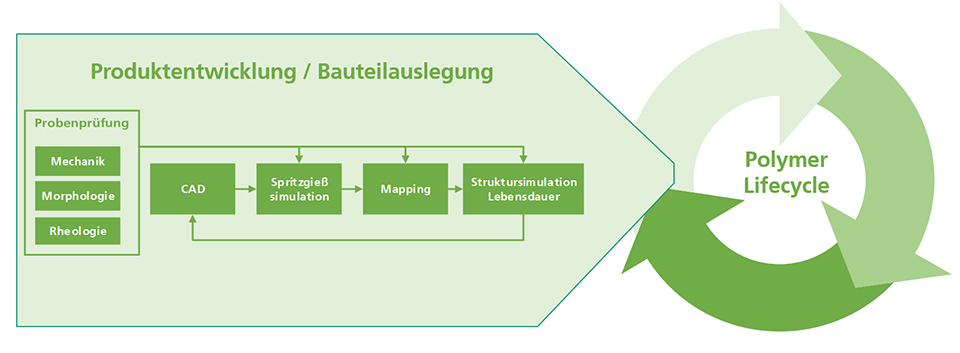knowledge management, ontology, design of polymer parts


The various processes in the life cycle of plastic components, such as granulation, product design, injection molding, operation and recycling have a significant influence on the properties of a component. As a result, over the life cycle of polymer components, a large number of material properties are determined using characterization tests, after which they are available in the form of material data.
Linking this data via a value chain that has been systematically digitized allows us to identify interactions between production, material characteristics and properties of products while in operation that were previously unthought of, these already playing an important role in relation to plastic components. This offers a wide range of possibilities for entirely new opportunities for optimization throughout the entire material cycle by means of machine learning (ML) methods, such as new potential for lightweight construction and the strengthening of the cyclical process. This requires a uniform digital knowledge representation of the real and numerical processes from which the data originates, as the basis for accessing the data through ML methods. This formalized representation of data and the relationships between them is created using a so-called “ontology” and can be read by both people and machines.
As a use-case of the DMD4Future project – spanning the entire Fraunhofer-Gesellschaft – six institutes are looking at different aspects of the life cycle of polymers to create a unified ontology. Measurement and process data or the results of numerical simulations have, up until now, contained metadata, which, in the past, was largely ignored during the design process. Machine learning methods make it possible to use this data. The work of Fraunhofer LBF therefore included the creation of a digital representation of the product design.
The focus is on the design of short-fiber-reinforced materials, since the interactions between the manufacturing process and material properties via the fiber orientation distribution are clearly evident here. In this context, ontologies and process graphs for the injection molding simulation, structure simulation, mapping and related real measuring processes such as the fiber orientation analysis are established. These represent important processes that form part of integrative product design. The ontology derived from this allows for merged data sets with differently scaled informational content that cuts across institutional boundaries, allowing for significantly larger parameter spaces to be mapped uniformly. This will make it possible to gain a holistic understanding of product design in the future and allow for the utilization of relationships between effects throughout the entire life cycle, with the aim of making it possible to utilize reliable digitized development and validation. In this way, a basis for creating valid digital twins for plastic components and incorporating them into digital evaluation chains has been established.